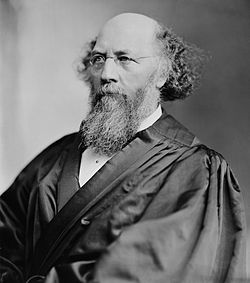Internal procedure
The Court is open for business year-round (as opposed to operating only during scheduled "terms" as is commonplace in jurisdictions that observe the legal year). The Court hears oral argument at least one week per month, 10 months each year (except July and August). It has been headquartered in San Francisco since 1874. [2] Since 1878, it has regularly heard oral argument each year at San Francisco (four months), Los Angeles (four months), and Sacramento (two months).
According to Justice Liu, when a case is granted review, the Chief Justice assigns the case to a justice, who, after the parties finish briefing, then prepares a draft opinion. [26] Each justice writes a preliminary response to the draft opinion, and if the assigned justice is in the minority, she may ask the Chief Justice to reassign the case to someone in the majority. [26] The Court then hears oral arguments and, immediately afterwards, meet alone to vote. [26] The California Constitution requires suspension of the justices' salaries if the Court fails to then file a decision within 90 days. [26] [27] The Court issues unanimous opinions in 77% of cases, compared to 43% by the Supreme Court of the United States. [26]
Throughout the year (including July and August), the justices have a conference every Wednesday the Court is not hearing oral argument, with the exception of the last week, respectively, of November and December (Thanksgiving and New Year's). New opinions are published online on Monday and Thursday mornings at 10 a.m. Paper copies also become available through the clerk's office at that time.
The Court is one of the few U.S. courts apart from the U.S. Supreme Court that enjoys the privilege of having its opinions routinely published in three hardcover reporters. The Court's Reporter of Decisions contracts with a private publisher (currently LexisNexis) to publish the official reporter, California Reports, now in its fifth series; note that the series number changes whenever the publisher changes, although the most recent changeover to the fifth series did not involve a change in reporter. West publishes California decisions in both the California Reporter (in its second series) and the Pacific Reporter (in its third series). (The New York Court of Appeals opinions are similarly published in three reporters.)
Each justice has five assigned chambers attorneys. [26] Since the late 1980s, the Court has turned away from the traditional use of law clerks, and has switched to permanent staff attorneys. [28] Justices Goodwin Liu and Leondra Kruger, however, have returned to the traditional use of recent law school graduates as one-year clerks for some of their staff positions. [26] The Court has about 85 staff attorneys, some of whom are attached to particular justices; the rest are shared as a central staff. [29] [30] The advantage to this system is that the reduced turnover of staff attorneys (versus the traditional system of rotating through new law clerks every year) has improved the efficiency of the court in dealing with complex cases, particularly death penalty cases.
During its first half-century of operation, the Court struggled to keep up with its soaring caseload and very frequently fell behind, until the California Courts of Appeal were created in 1904. [2] [14] This resulted in provisions in the 1879 Constitution requiring the Court to decide all cases in writing with reasons given [2] [31] (to get rid of minor cases, it had often given summary dispositions with no reasons given [2] [14] ) and requiring California judges to certify in writing every month that no matter submitted for consideration had been outstanding for more than 90 days, or else they will not be paid. [2] [32] [33] To comply with the latter provision, the Court does not schedule oral argument until the justices and their staff attorneys have already studied the briefs, formulated their respective positions, and circulated draft opinions. Then, after the matter is formally "argued and submitted" before the Court, the justices can polish and file their opinions well before reaching the 90-day deadline. This differs sharply from the practice in all other federal and state appellate courts, where judges can schedule oral argument not long after written briefing is finished, but then may take many months (or even a year) after oral argument to file their opinions.
Historical procedure
In March 1885, the state legislature authorized the creation of the Supreme Court Commission to help with the Court's overwhelming backlog of pending appeals. [2] The justices were initially allowed to hire three commissioners. [2] Since oral argument was not mandatory except for in bank hearings of appeals, the justices began to assign cases to the commissioners which could likely be resolved on the briefs alone. [2] The number of commissioners was expanded in five in 1889. [2]
In retrospect, the commissioners can be seen as an important precursor of the law clerks and staff attorneys which the Court began to hire in the 1930s. [2] In contrast to modern practice, where appellate justices are expected to take ownership of the opinions to which they sign their names and staff members are mere ghostwriters, the commissioners openly signed their opinions. [2] Each of the approximately 4,400 appeals (3,700 reported, 700 unreported) handled by the commissioners was resolved by an opinion signed by one commissioner with the concurrence of two others. [2] The opinions always ended in a recommended disposition, such as: "We find no error in the record and the judgment should be affirmed." [2] Originally, this was followed by a one-line unsigned per curiam statement in the name of "The Court," such as: "For the reasons given in the foregoing opinion the judgment is affirmed." [2] Starting in 1892, the three justices who reviewed and summarily adopted each commissioners' opinion began to also sign their names. [2]
The commissioners were only partially successful in reducing the chronic backlog. [2] The Commission was also subject to heavy criticism as an unelected "auxiliary court". [2] Attorneys who enjoyed appellate work but had difficulty holding onto judicial seats in partisan elections repeatedly bounced back and forth between serving as elected justices and unelected commissioners. [2] After two more decades of debate, the state legislature recognized that the state needed to establish intermediate appellate courts and referred the issue to the electorate. [2] In November 1904, Senate Constitutional Amendment No. 2 was approved by the state's voters, which abolished the Supreme Court Commission and created the California Courts of Appeal. [2] All five commissioners were promptly appointed in 1905 to serve among the original nine justices of the Courts of Appeal. [2]









































